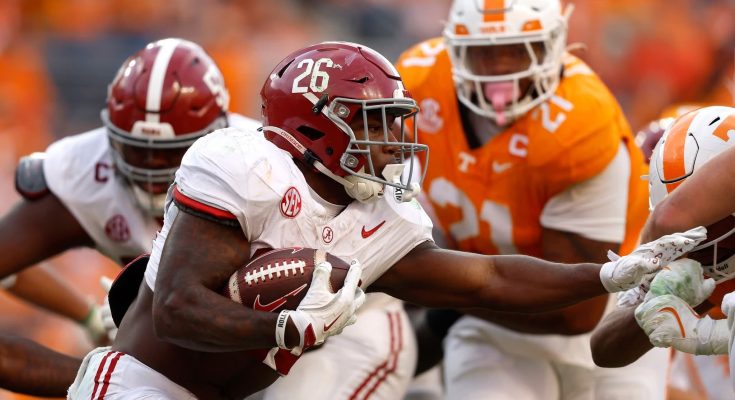Kalen DeBoer’s comment that “we’re going to think optimistically” about Jam Miller’s concussion reflects a mix of hope, cautious realism, and the tightrope that coaches often walk when dealing with player health in football. To fully unpack the significance, it helps to consider what we know about Miller’s season, concussion protocols in college football, Alabama’s situation at running back, and the balance coaches must strike between competitive urgency and caution.
So far this season, Jam Miller has been one of Alabama’s most reliable offensive weapons, despite some early setbacks. He missed the first three games due to a collarbone injury suffered in fall camp, but after returning, he accumulated 58 carries for 267 yards and a touchdown in just three games. (ESPN.com) His versatility in the run game, combined with pass protection and blocking ability, makes him a valuable part of the Crimson Tide offense. Yet against Missouri, Miller sustained a concussion after what appeared to be a hard landing, and was forced out of the game. (Saturday Down South) He entered the standard concussion protocol, and now his availability for the upcoming game vs. Tennessee is uncertain. (ESPN.com)
In light of that, DeBoer’s phrasing — “we’re going to think optimistically … He’s making good progress … We’re not sure yet where that stands” — is more than just motivational rhetoric. It signals that the staff is paying close attention to Miller’s recovery trajectory and wants to signal confidence without overcommitting. (Saturday Down South) The “optimistically” part suggests that the coaches and medical staff will favor giving him the benefit of the doubt, while “there are steps … it can go a lot of different directions” acknowledges the inherent uncertainty. (Saturday Down South)
That uncertainty is baked into concussion management in football. Unlike many other injuries, concussions don’t have a fixed timeline — every athlete’s brain reacts differently, and symptoms, severity, recovery speed, and risk of re-injury all vary. Medical protocols typically require a player to clear a sequence of steps (symptom resolution at rest, light exercise, non-contact practice, full-contact practice, etc.) before being cleared to play. Coaches in that process must remain flexible, responsive to medical advice, and often ready to adjust their plans late in the week depending on how a player is doing. DeBoer’s remarks reflect that uncertainty: he clearly doesn’t want to rush Miller back prematurely, but also doesn’t want to rule him out without reason.
From Alabama’s standpoint, the offense is already dealing with inconsistencies in the running game. The Crimson Tide’s rush attack has lagged overall, averaging only about 126.5 yards per game. (BVM Sports) Bringing Miller back would provide a boost not just in production but also in confidence, balance, and depth. The fact that DeBoer is keeping Miller in the “questionable” classification on the injury report (rather than “out”) shows that he wants to leave open the possibility for Miller to play, assuming his recovery allows it. (On3)
But optimism doesn’t guarantee availability. There remains the possibility that Miller’s symptoms don’t sufficiently recede, or that medical staff insist on additional rest. DeBoer’s mention that “there are steps … it can go a lot of different directions” is an implicit reminder to fans and the team that this is an evolving condition. Meanwhile, the Alabama coaching staff must continue preparing other backs — Kevin Riley, AK Dear, Daniel Hill, Richard Young, etc. — to absorb more carries or step into larger roles should Miller be held out. (KNBR)
DeBoer’s choice of language — optimistic but cautious — also serves a motivational role. For players, staff, and fans, he is projecting confidence and hope, which can help maintain morale and belief, especially when dealing with injury-related adversity. But by coupling optimism with disclaimers (“we’re not sure,” “steps along the way”), he avoids creating unrealistic expectations or seeming to pressure medical clearance decisions. That balancing act — between inspiring confidence and respecting medical realities — is part of what head coaches must manage when dealing with key injuries.
In sum, DeBoer’s statement underscores that Alabama is hopeful Miller can recover in time, but is not banking on it prematurely. His words reflect the realities of concussion recovery, the high stakes of Miller’s role in the offense, and the need to manage both expectations and contingency plans. Whether that optimism will bear fruit depends on how Miller progresses through the concussion protocol over the coming days. Would you like me to track Miller’s status updates through the week or project how Alabama might adjust their game plan if he doesn’t play?


